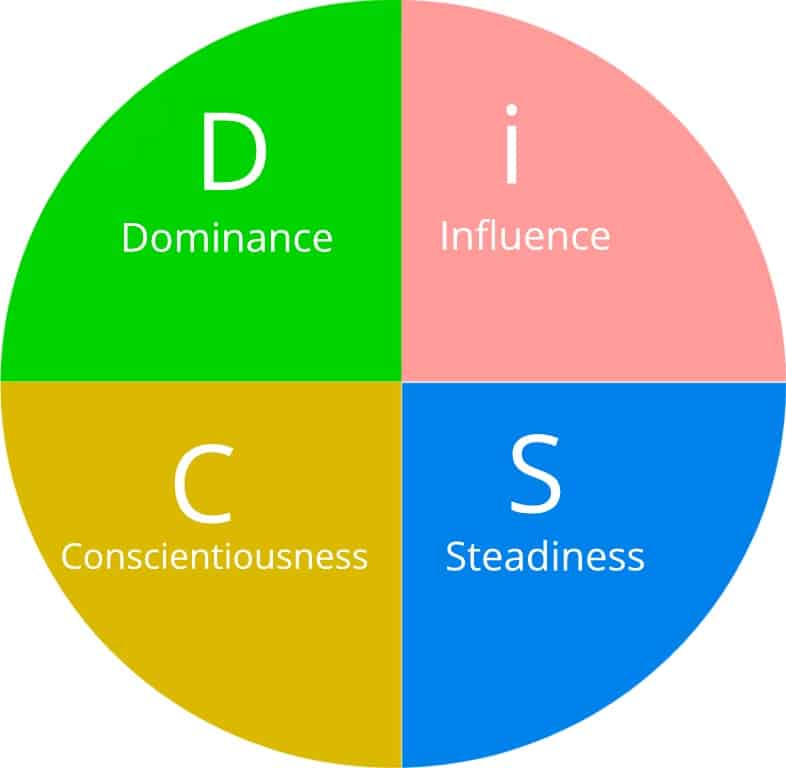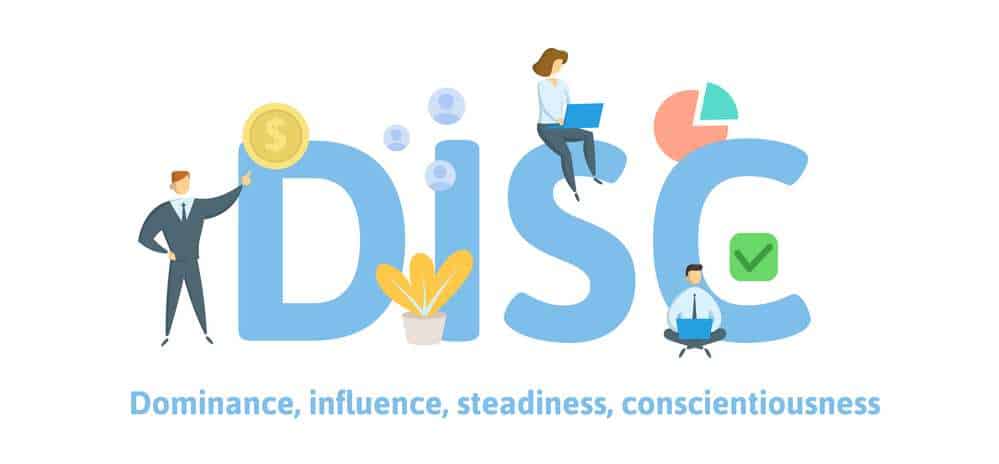What is a DiSC Assessment?
What is the DISC Personality Testing, and What is it Used For?
The DiSC Personality Test is a famous personality profile test that measures four main traits: Dominance (D), Influence (I), Steadiness (S), and Conscientiousness (C).
It is based on the DISC Personality Model, proposed in 1928 by psychologist William Moulton Marston, who also happened to build an early version of the lie detector and create the comic book hero Wonder Woman (Wikipedia).

Marston was unique in his time for focusing on the personalities of ordinary people who were not struggling with mental illness. His book, Emotions of Normal People, describes how people perceive and interact with their environments.
What does DiSC Stand For?
DiSC is an acronym that represents the four main personality types in a DiSC Assessment Test: (D) Dominant, (i) Influence, (S) Steadiness, and (C) Conscientious.
The DiSC Personality Model
The DISC personality model is a circular grid divided into four quadrants. Each one of the quadrants represents a primary trait, as mentioned before; Dominance (D), Influence (I), Steadiness (S), and Conscientiousness (C).
In his book, Marston called the emotions Dominance, Inducement, Submission, and Compliance and defined them based on the observed behavior.
DISC Quadrants
The DISC profile quadrants (the DISC circle) are typically represented in the image below. Reading left to right, you can see it spells out DiSC.

The 12 DISC Types
Four Main Personality Types for DISC
There are four main DiSC profile assessment types. They are the following:
- Dominant (or D Profile Style)
The Dominant personality profile combines both task orientation and directness. People with a Dominant profile are focused and determined. They are oriented toward the results rather than the process. - Influence (or I Profile Style)
The Influence personality is the most outgoing person on the team and the most social. They are the team’s most enthusiastic and persuasive people and are oriented toward connecting with others. - Steadiness (or S Profile Style)
The Steadiness personality profile type is the most sympathetic and even-tempered. They combine patience and calm with a more moderate pace. - Conscientious (or C Profile Style)
The Conscientious personality combines an analytical orientation with attention to detail. They combine a moderate pace with a systematic approach to tasks.
DISC ASSESSMENT PROFILE STYLE | PROFILE CHARACTERISTICS |
Dominant (or D Profile Style) | Task oriented, direct, focused, determined. Oriented towards results rather than the process. |
Influence (or I Profile Style) | Outgoing and social. Enthusiastic and persuasive. Love making connections with others. |
Steadiness (or S Profile Style) | Sympathetic and even-tempered. Patient, calm, moderate. |
Conscientious (or C Profile Style) | Analytical with attention to detail. Combine a moderate pace with a systematic approach. |
Personality Types
Some personality styles are combination styles and fall within two different categories. They have also been profiled in the Everything DiSC group of tests.
Dominance/Influence
There are two subcategories of Dominance/Influence.
- The Di Style
The Di Style (more Dominant) can convince others by the sheer force of their personality. This DiSC profile is bold and daring. - The iD Style
The iD Style (more Influence) inspires others more with their enthusiasm.
Influence/Steadiness
Likewise, there are two subcategories of Influence/Steadiness.
- The iS Style
The style (more Influence) is upbeat, lighthearted, and cheerful. - The Si Style
The Si style (more Steadiness) is supportive and amiable.
Steadiness/Conscientiousness
The hybrid styles combining Steadiness and Conscientiousness are the most deliberate in decision-making, cautious and passive.
- The SC Style
The SC style (more Steadiness) prefers to work behind the scenes, where attention to detail will not attract notice. - The CS Style
The CS style (more Conscientious) is more self-controlled and submissive.
Conscientiousness/Dominance
Subcategories that combine Conscientiousness with Dominance include CD (more Conscientious) and DC (more Dominant).
- The CD Style
People with a CD profile tend to be straightforward. - The DC Style
People with the DC profile are strong-willed.
High Dimensions
The DiSC Assessment test types were developed using the reactions and preferences of ordinary people, so no style is better or worse than any other. All people can develop leadership skills, work together in teams, and accomplish the tasks before them. People with different personality types may go about those tasks in different ways.
When people take the DiSC tests, they receive scores on eight mathematical scales. The highest scores correspond to the personality type that has the best fit. Often, only one type emerges, but sometimes more than one will have high dimensions.
- High D
While people can be described as having a High D Style, it doesn’t mean they have only Dominant traits. They have elements of the other profiles as well, so that a person may feel more comfortable with Dominance’s higher energy and skepticism but be able to express other traits also. People with a High D profile place a great deal of emphasis on achievement, success, and competition. They are motivated by control. - High I
People with a High I style excel in communicating with others. They are outgoing, social, enthusiastic, and confident. They value positive relationships with those around them. - High S
People with a High S style are patient, calm, and value positive interactions. They maintain supportive relationships with people and are intensely loyal. - High C
People with a High C Style are analytical and controlled. They are conscientious, attentive to detail, and value rules and structures.
What does the DiSC Assessment Measure?
The DiSC assessment measures general behavioral styles and preferences, such as the pace of the environment or reactions to the rules that others set.
The DiSC test does not measure the entirety of a person’s personality, such as their cognitive style, feelings, or values. And nor does it measure intelligence, aptitude, or mental illness.
Since the DiSC theory is based on the responses of ordinary people, it does not measure or diagnose mental illness.
Accuracy, Validity, and Reliability
Assessments based on the DISC theory have been around for about 40 years.
The presentation has changed and modified with time as researchers have developed more effective ways to help people find their best mix of behavioral styles.
The latest forms of the test allow for adaptive assessment, a dynamic form of computerized assessment that changes with the responses of the person taking the examination. That makes the profile that much more accurate.
To evaluate any assessment, researchers ask about its reliability and validity. Those two concepts are related, but they are not the same.
Reliability of the DiSC Assessment
Reliability refers to how consistent measurements are. Think of measuring length with a ruler. If that ruler is made of a hard substance, sizes may be the same each time the same distance is measured. Suppose that ruler was made of modeling clay that stretches and bends. The dimensions of that same distance might not be even close, and they might even vary randomly, depending on how the bendy-ruler was shaped.
In much the same way, researchers ask about measurements in psychological assessments. There are a variety of statistical techniques that “crunch the numbers” and measure how reliable a test is. One of those measurements is called test-retest reliability, which means that a group of people take the same assessment more than once to see how closely the patterns at one time correlate with those when the evaluation is carried out a second time. (Often, test-retest reliability is measured two weeks apart to counter what people will remember answering.)
The second part of reliability deals with how consistently things that measure similar traits measure them. In an assessment like Everything DiSC, where different scales are being measured, it’s a matter of seeing if they are internally consistent. Tests based on the DISC theory, from the earliest Activity Vector Analysis to the Everything DiSC series, have been studied and measured for both types of reliability to show that different factors and behavioral styles are being measured.
Validity of the DiSC Assessment
Validity concerns how accurately an assessment measures the construct it is designed to measure.
There are many ways to define validity.
The DISC model proposed four different behavior styles: Dominant, Influence, Steadiness, and Consistency.
According to the model, styles which are closer together (such as Dominance and Influence) should be more closely correlated than those which are further apart (such as Dominance and Steadiness).
When accurate responses to questions are compared, correlations follow that pattern. (Detailed results can be found in the discussion of Everything DiSC research.)
Another way to measure validity is to compare the theoretical model with accurate scores on the Everything DiSC Assessment.
Suppose the theoretical DiSC model for Everything DiSC is a circle with eight measurement scales at the same distance from the center. In that case, the real-world measurements should approximate a loop when all of them are viewed simultaneously. (This technique is called “multidimensional scaling” and involves many data points that can be mapped in a multidimensional sequence.)
Why is the “i” in DiSC Lower Case (i.e., not capitalized like the other letters)?
The “i” in DiSC is lowercase because a printer accidentally left the letter I in lowercase. The publisher decided to copyright the mistake and reserve DiSC as their trademark.
Everything DiSC is a group of tests that help people function best in teams and workplaces. A balanced squad has individual members with different personality types, as predicted by the model. The theory is that people with different personalities can mesh together and capitalize on their strengths.

